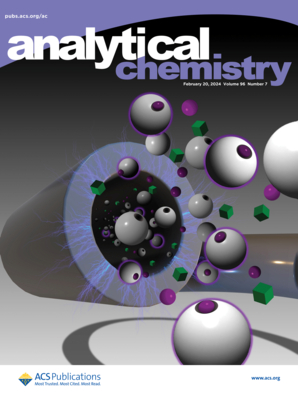“Bis-Clamp-Cavity Synergy”, an Efficient Approach to Improve Guest Binding Properties of Macrocyclic Host and Its Application on Detection of Al3+ and Arg in Living Cells
IF 6.7
1区 化学
Q1 CHEMISTRY, ANALYTICAL
引用次数: 0
Abstract
Improving the selective and sensitive binding properties of macrocyclic hosts to target guests is always an interesting challenge. Herein, we introduce a novel “bis-clamp-cavity synergy” strategy to enhance the selectivity and binding sensitivity of pillararenes toward target guests. To achieve this goal, we designed and synthesized A,A′-bis-hydroxynaphthoylhydrazone-functionalized conjugated pillar[5]arene (HGP5), in which bis-hydroxynaphthoylhydrazone plays the role of clamps, while the pillar[5]arene provides the macrocyclic cavity. The bis-clamps and macrocyclic cavity could supply synergistic binding for target guests through multicoordination interactions, multihydrogen bonds, C–H···π and cation···π interactions, and so on. Furthermore, the introduction of the conjugated pillar[5]arene can enhance the signal transmission ability, thereby improving the sensitivity for guest recognition. Benefiting from the bis-clamp-cavity synergy, HGP5 exhibits efficient selective recognition for Arg and Al3+. It achieves colorimetric and fluorescent dual-channel recognition for Arg (with the LOD of 2.99 × 10–8 M) and ultrasensitive recognition of Al3+ (with the LOD of 7.94 × 10–9 M). This strategy can be effectively applied to detect Arg and Al3+ in aqueous solution and live cells."双钳腔协同作用"--改善大环宿主客体结合特性的有效方法及其在活细胞中检测 Al3+ 和 Arg 中的应用
提高大环宿主对目标客体的选择性和结合灵敏度一直是一个有趣的挑战。在本文中,我们介绍了一种新颖的 "双钳腔协同 "策略,以提高柱状烯类对目标客体的选择性和结合灵敏度。为了实现这一目标,我们设计并合成了 A,A′-双羟基萘甲酰腙功能化共轭柱状[5]炔(HGP5),其中双羟基萘甲酰腙起夹持作用,而柱状[5]炔则提供大环空腔。双钳和大环腔可通过多配位相互作用、多氢键、C-H--π和阳离子--π相互作用等为目标客体提供协同结合。此外,共轭柱[5]炔的引入可以增强信号传输能力,从而提高客体识别的灵敏度。得益于双钳腔协同作用,HGP5 对 Arg 和 Al3+ 具有高效的选择性识别能力。它实现了对 Arg 的比色和荧光双通道识别(LOD 为 2.99 × 10-8 M)和对 Al3+ 的超灵敏识别(LOD 为 7.94 × 10-9 M)。这种策略可有效地用于检测水溶液和活细胞中的 Arg 和 Al3+。
本文章由计算机程序翻译,如有差异,请以英文原文为准。
求助全文
约1分钟内获得全文
求助全文
来源期刊

Analytical Chemistry
化学-分析化学
CiteScore
12.10
自引率
12.20%
发文量
1949
审稿时长
1.4 months
期刊介绍:
Analytical Chemistry, a peer-reviewed research journal, focuses on disseminating new and original knowledge across all branches of analytical chemistry. Fundamental articles may explore general principles of chemical measurement science and need not directly address existing or potential analytical methodology. They can be entirely theoretical or report experimental results. Contributions may cover various phases of analytical operations, including sampling, bioanalysis, electrochemistry, mass spectrometry, microscale and nanoscale systems, environmental analysis, separations, spectroscopy, chemical reactions and selectivity, instrumentation, imaging, surface analysis, and data processing. Papers discussing known analytical methods should present a significant, original application of the method, a notable improvement, or results on an important analyte.
 求助内容:
求助内容: 应助结果提醒方式:
应助结果提醒方式:


